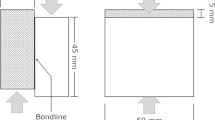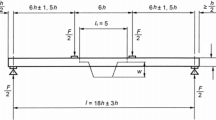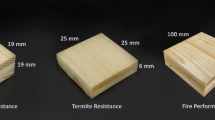Abstract
To better use the second-growth wood resources in value-added applications, this work addressed the manufacturing aspects of cross-laminated timber (CLT) products from western hemlock (Tsuga heterophylla (Raf.) Sarg) and amabilis fir (Abies amabilis (Dougl.) Forbes) (or hem-fir) harvested from coastal British Columbia, Canada. Small CLT billets (nominal 610 mm × 610 mm) were made to examine CLT bond quality and durability through block shear and delamination tests. Two types of adhesives, single-component polyurethane (PUR) and emulsion polymer isocyanate (EPI) and two critical applied pressure parameters (0.28 and 0.83 MPa) were adopted to manufacture hem-fir CLT. It was found that the adhesive type and applied pressure significantly affected wood failure percentage (WFP) and delamination of hem-fir CLT. When PUR adhesive was used, CLT made at 0.83 MPa pressure yielded significantly higher WFP and lower delamination than that made at 0.28 MPa pressure. The results demonstrated that despite the fact that hem-fir lumber is not particularly specified in the current North American CLT standard, it could be used for manufacturing CLT with the required panel bond quality.



Similar content being viewed by others
References
Aicher S, Reinhardt HW (2007) Delamination properties and shear strength of glued beech wood laminations with red heartwood. Holz Roh Werkst 65(2):125–136
ANSI/AITC A190.1 (2007) Structural glued laminated timber, American Institute of Timber Construction, USA
ANSI/APA PRG 320 (2012) Standard for performance-rated cross-laminated timber, The Engineered Wood Association, USA
ASTM D 905–08 (2013) Standard test method for strength properties of adhesive bonds in shear by compression loading, American Society for Testing and Materials (ASTM)
BCMFR (2007) Coastal Forest Action Plan, British Columbia Ministry of Forests and Range, Victoria. http://www.for.gov.bc.ca/CoastalPlan/cap07.pdf. Accessed 10 March 2009
Bejtka I, Lam F (2008) Cross laminated timber as innovative building material. In: Proceedings of Canadian Society of Civil Engineering (CSCE) 2008 annual conference, Québec-QC, Canada
Betti M, Brunetti M, Lauriola MP, Nocetti M, Ravalli F, Pizzo B (2016) Comparison of newly proposed test methods to evaluate the bonding quality of cross-laminated timber (CLT) panels by means of experimental data and finite element (FE) analysis. Constr Build Mater 125:952–963
Brandner R, Flatscher G, Rignhofer A, Schickhofer G, Thiel A (2016) Cross laminated timber (CLT): overview and development. Eur J Wood Prod 74(3):331–351
Canada Wood (2016) The world first large-dimension hemlock CLT production CLT line was put into use. https://mp.weixin.qq.com/s?__biz=MjM5NTg5NDI4Mg==&mid=2651228420&idx=1&sn=027306c8724ef5c02e24d4238efd33d9#rd
CSA O112.10–08 (2008) Evaluation of adhesives for structural wood products (limited moisture exposure), Canadian Standards Association, Mississauga
CSA O122–06 (2006) Structural glued-laminated timber, Canadian Standards Association, Mississauga
CSA O177–06 (2006) Qualification code for manufacturers of structural glued-laminated timber, Canadian Standard Association, Mississauga
Custodio J, Broughton J, Cruz H (2009) A review of factors influencing the durability of structural bonded timber joints. Int J Adhes Adhes 29(2):173–185
EN 14080 (2013) Timber structures-glued laminated timber and glued solid timber-requirements. European Committee for Standardization CEN, Bruxelles
EN 302 (2013) Adhesives for load-bearing timber structures-Test methods, European Committee for Standardization, Bruxelles
FPL (1999) Wood handbook-Chap. 4 Mechanical properties of wood. Forest Products Laboratory, U.S. Department of Agriculture (USDA), Forest Service, Forest Products Laboratory, Madison
Gong Y, Wu G, Ren H (2016) Block shear strength and delamination of cross-laminated timber fabricated with Japanese larch. BioResources 11(4):10240–10250
Knorz M, Schmidt M, Torno S, van de Kuilen JWG (2014) Structural bonding of ash (Fraxinus excelsior L.): resistance to delamination and performance in shearing tests. Eur J Wood Prod 72(3):297–309
Lavisci P, Berti S, Pizzo B, Triboulot P, Zanuttini R (2001) A shear test for structural adhesives used in the consolidation of old timber. Holz Roh Werkst 59(1/2):145–152
Li RR, Cao PX, Guo XL, Ekevad M (2015) Comparison of different standard test methods for compressive shear strength of bondline in glulam. China For Sci Technol 29(4):86–89
Liao YC, Tu DY, Zhou JH, Zhou HB, Yun H, Gu J, Hu CS (2017) Feasibility of manufacturing cross-laminated timber using fast-grown small diameter eucalyptus lumbers. Constr Build Mater 132:508–515
Okkonen AE, River BH (1989) Factors affecting the strength of block-shear specimens. Forest Prod J 39(1):43–50
Pizzo B, Lavisci P, Misani C, Triboulot P, Macchioni N (2003) Measuring the shear strength ratio of glued joints within the same specimen. Holz Roh Werkst 61(4):273–280
Raftery G, Harte A, Rodd P (2008) Qualification of wood adhesives for structural softwood glulam with large juvenile wood content. J Inst Wood Sci 18(1):24–34
SAS Institute (2017) JMP statistical discovery software. https://www.jmp.com/en_us/software/data-analysis-software. SAS Campus Drive, Cary
Schmidt M, Glos P, Wegener G (2010) Gluing of European beech wood for load bearing timber structures. Eur J Wood Prod 68(1):43–57
Serrano E (2004) A numerical study of the shear-strength-predicting capabilities of test specimens for wood-adhesive bonds. Int J Int J Adhes Adhes 24(1):23–35
Sikora KS, McPolin DO, Hare AM (2015) Shear strength and durability testing of adhesive bonds in cross-laminated timber. J Adhes 92(7–9):758–777
Steiger R, Gehri E, Richter K (2010) Quality control of glulam: shear testing of bondlines. Eur J Wood Prod 68(3):243–256
Wang BJ, Dai C (2008) Present utilization and outlook of BC Hem-fir for composite products. BC coastal forest sector development program report, Department of Engineered Wood Products, FPInnovations, Vancouver
Wang BJ, Dai C (2013) Development of structural laminated veneer lumber from stress graded short-rotation hem-fir veneer. Constr Build Mater 47:902–909
Wang BJ, Dai C, Middleton G, Munro D (2010a) Characterizing short-rotation coastal hemlock and amabilis fir veneer properties: preliminary results. BC coastal forest sector development program report, Department of Engineered Wood Products, FPInnovations, Vancouver
Wang BJ, Dai C, Middleton G (2010b) Manufacturing and performance evaluation of LVL made from stress graded hem-fir veneer. BC coastal forest sector development program report, Department of Engineered Wood Products, FPInnovations, Vancouver
Wang BJ, Pirvu C, Lum C (2011) CLT Handbook: Chap. 2 Cross-laminated Timber manufacturing, Canadian ed. FPInnovations, Vancouver
Wernersson H (1994) Fracture characterization of wood adhesive joints. Report TVSM 1006, Division of Structural Materials. Lund University, Lund
Acknowledgements
The authors would like to thank Natural Resources Canada (Canadian Forest Service) and the Province of British Columbia for their guidance and financial support for this research. This work was also supported by the natural science research general project of Jiangsu Province of China (16KJD220001), the science project of Jiangsu Vocational College of Agriculture and Forestry (2017kj04), and Ningbo major social development project entitled “Development of new green prefabricated building materials for demonstration buildings” (2017C510004). The authors thank Ciprian Pirvu, Conroy Lum, Romulo Casilla, John Hoffmann, and Gordon Chow, among others at FPInnovations, for their help in this work.
Author information
Authors and Affiliations
Corresponding author
Rights and permissions
About this article
Cite this article
Wang, J.B., Wei, P., Gao, Z. et al. The evaluation of panel bond quality and durability of hem-fir cross-laminated timber (CLT). Eur. J. Wood Prod. 76, 833–841 (2018). https://doi.org/10.1007/s00107-017-1283-7
Received:
Published:
Issue Date:
DOI: https://doi.org/10.1007/s00107-017-1283-7




